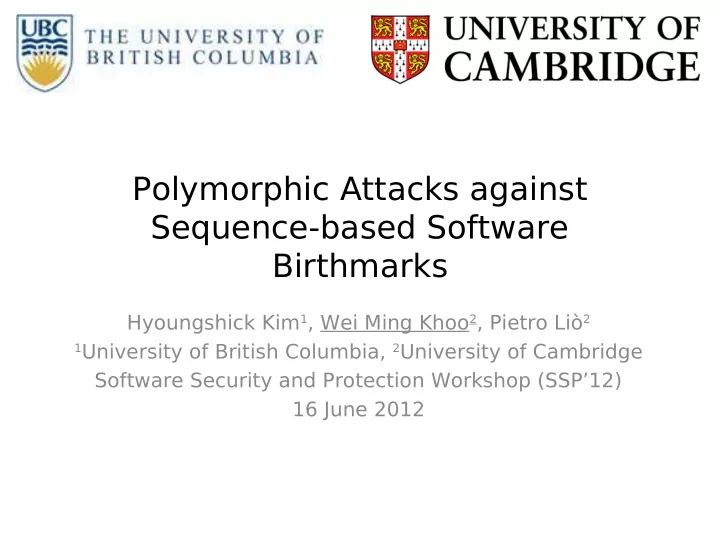

Polymorphic Attacks against Sequence-based Software Birthmarks Hyoungshick Kim 1 , Wei Ming Khoo 2 , Pietro Liò 2 1 University of British Columbia, 2 University of Cambridge Software Security and Protection Workshop (SSP’12) 16 June 2012
Background • A software birthmark is “...a characteristic(s) inherent to a program that uniquely identifies it” (Myles & Collberg, 2004) • We consider the clone detection problem P1 Bob P P2 P1 == P2? Alice Honest software vendor Evil software analyst
Software birthmark detection • 2 Phases: Bob first applies birthmarking function mark() • Then applies detection function detect() • Alice wins if B1 != B2 ( ! detect()) when P1 == P2 • Bob wins if B1 == B2 (detect()) when P1 == P2 mark(P1) P1 B1 mark(P2) P2 B2 detect(B1, B2)
Sequence-based birthmarks • Well-known birthmarking scheme [Tamada'04, Myles'05, Wang'09] – Sequence of API and system calls (or instructions) – Mark(P) is a sequence of symbols in a finite alphabet Σ = { a 1 ,..., a k } – E.g. { fopen, gettimeofday, fscanf, fclose,... }
Multiple Sequence Alignment (MSA) • Well-known bioinformatics problem [Higgins'88, Brudno'03, Edgar'04] • Recently found a use in software birthmarking [Park'08, Wang'09] • Alignment is a way of arranging two or more sequences to identify regions of similarity/dissimilarity • Given a set of n sequences, the goal is to generate an n x n distance matrix
Sequence alignment • Several parameters to optimize – Global/Local alignment (ClustalW) – Gap opening/extension cost – Match/mismatch cost - Gaps – For our purposes, set a threshold cmp-branch fn prologue distance imul Match Mismatch Gap opening
Our contributions • We show that the intuitive strategies of randomly inserting/deleting symbols are ineffective at defeating sequence alignment-based clone detection, even at high rates • Instead we show empirically that non-consecutive insertions and highest frequency deletions are twice as cost-effective • We also discuss the costs of such attacks, and propose using non-determinism through concurrent programming as an alternative strategy
Polymorphic Attacks
A simple attack • Random Insertion, INS(R) • Define insertion ratio x i ∈ [0, 2] • For a mark(P) of length n , choose n*x i bogus symbols from Σ and insert at random positions of mark(P) • Effectiveness? INS(R)
T est corpus ● FakAV-DO (trojan) ● Skyhoo (trojan) ● T riangle (benign) n – birthmark length ● Notepad (benign) m – number of unique symbols ● 7zip (benign) ● WinSCP (benign) ● Pin+VMWare used capture API call traces ● 48 birthmarks, 370 API/system calls
Parameter tuning ● T rained alignment parameters (gap opening, gap extension, mismatch costs), similarity threshold to get birthmark detection rate of 100%
Evaluation Detection rate Similarity score Fak-DO Notepad Skyhoo triangle Detection threshold: Similarity score is 0 Can we do better?
Non-consecutive insertion, INS(N) • Define insertion ratio x i ∈ [0, 2] For a mark(P) of length n , choose n*x i bogus symbols from Σ and group them into k sequences, b 1 ,..., b k • Divide mark(P) into sub-sequences σ 1 ,..., σ k Insert b i at the beginning of σ i INS(N)
Evaluation Detection rate Similarity score INS(N) ~twice as effective for the same x i How about deletion?
Deletion attacks • Random Deletion, DEL(R) • Define deletion ratio x d ∈ [0, 1] • For a mark(P) with m unique symbols, choose m*x d symbols and delete them from mark(P) ABCDEABCDEABCDEFABABCAABCDABCDEABCDEF DEL(R) , x d = 2/6
Highest frequency deletion, DEL(H) • Define deletion ratio x d ∈ [0, 1] • For a mark(P) with m unique symbols, choose the m*x d highest frequency symbol and delete it from mark(P) ABCDEABCDEABCDEFABABCAABCDABCDEABCDEF DEL(H), x d = 2/6
Evaluation Detection rate Similarity score How about hybrid attacks – insertion and deletion?
Hybrid attacks HYB(RR ) HYB(RN ) = INS(R) + DEL(R) = INS(N) + DEL(R) HYB(HR ) HYB(HN ) = INS(R) + DEL(H) = INS(N) + DEL(H) (Skyhoo)
Discussion
Discussion • How costly are these transformations? • Depends on – What is inserted/deleted – Where it is inserted/deleted Example • Inserting at location 0 is (mostly) free: – Packing is a special case of INS(N) with k=1 • If a loop occurs n times, inserting i in the loop implies inserting n copies • Is there an automated way?
Dynamic dependency profiling • Source-level dependence profiling for estimating potential parallelism (Mak et al. 2010) • Idea: Use data and control dependencies to identify the critical path of a program • Tasks not on the critical path can be refactored (within boundaries allowed by dependencies) • How about exploiting non-determinism?
Concurrency • Simulate effects of multi-threading on sequence alignment • Define 100% parallelism as n threads of equal length • Define 0% parallelism as 1 thread • However, parallel programming is hard to get correct • Dummy threads have to factor cost and resiliency
Conclusions & Future work • Random insertions/deletions were not effective • HYB(HN) was most cost effective attack strategy • To look at: • Dependency profiling on binaries • Static birthmarking schemes • Evaluating larger corpus, other code transformations
Recommend
More recommend